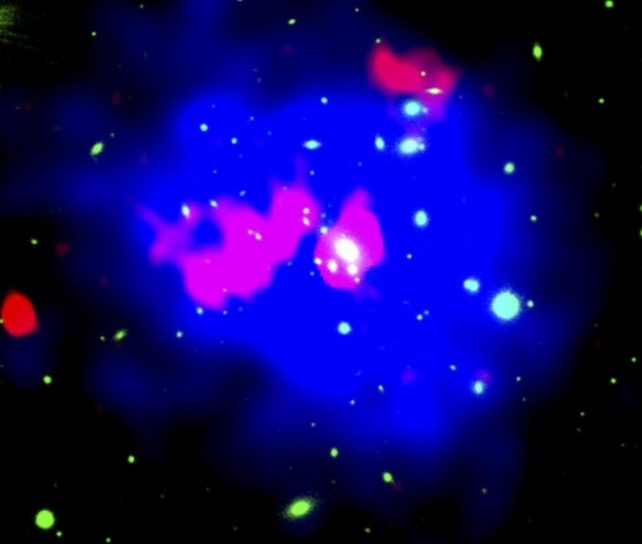[ad_1]
If we had been round and in a position to see into the center of galaxy cluster Abell 980 round 260 million years in the past, we could have seen one thing very spectacular certainly.
The brightest galaxy within the cluster erupted, the results of exercise from its supermassive black gap, an occasion that might go on to blow large bubbles emitting radio gentle out into area.
Astronomers, led by Surajit Paul of Savitribai Phule Pune College in India, say that these newly found bubbles – often called radio lobes, or a radio galaxy – are the oldest of their variety we have ever seen.
Furthermore, a pair of youthful lobes has been discovered. A second staff of astronomers led by Gopal Krishna of the College of Mumbai in India has traced these to the identical dad or mum galaxy, making the mixed object a uncommon instance of a double pair of lobes – suggesting that the galaxy’s supermassive black gap has erupted episodically.

Since radio lobes can lengthen tens of millions of light-years, a lot bigger than the galaxies from which they erupt, they’ll have an effect on the intergalactic medium, the tenuous gasoline between galaxies. Finding out these constructions can assist us higher perceive this medium, in addition to the recurrent, episodic exercise of the supermassive black holes that create them.
Radio lobes are pretty widespread within the Universe. Even the Milky Means has radio lobes. They’re produced when a supermassive black gap has an lively section, slurping down matter from the area round it.
Whereas a lot of the materials falls onto the black gap, a few of it’s accelerated alongside the black gap’s exterior magnetic discipline traces to its poles, the place it’s launched into area as two jets touring at a big share of sunshine pace.
These jets punch into intergalactic area, the place they increase into lobes that work together with the intergalactic medium. These lobes act as a synchrotron to speed up electrons, producing radio emissions.
The issue is that they very quickly fade away past our capability to detect them, and it is uncommon to seek out examples past round 200 million years outdated, as we view them. Nevertheless, such relics can report useful details about the circumstances by which they fashioned.
Paul and his colleagues hypothesized that one setting more likely to delay their survival is the recent, relaxed medium of a low-mass and quiet galaxy cluster.
Utilizing the Big Metrewave Radio Telescope in India, they went trying in galaxy clusters for simply such an setting – and so they discovered one, in Abell 980, positioned round 2 billion light-years away. There, they detected faint radio constructions – lobes that they had been in a position to age to about 260 million years outdated, spanning a distance of 1.2 million light-years.
Subsequent was figuring out the place the lobes had come from.
In a second paper, Krishna and his colleagues had been in a position to hint it to the brightest galaxy within the cluster. Now, it may be discovered within the heart of Abell 980; nonetheless, Krishna and his staff confirmed that it wasn’t all the time in that place. Over 260 million years or so, it migrated 250,000 light-years, from the place at which it emitted the primary pair of lobes.
As soon as within the cluster heart, the galaxy then erupted once more, producing a second pair of lobes. Astronomers have discovered, to this point, only a few dozen examples of galaxies which have been linked with two pairs of radio lobes, referred to as double-double radio galaxies.
As a result of the dad or mum galaxy of the 2 pairs of lobes in Abell 980 has migrated, separating the lobes, Krishna and his staff have named these galaxies ‘indifferent double-double radio galaxies’. It is also even rarer than double-double radio galaxies; simply two different candidates have been reported, making this discovery essentially the most believable instance but, the researchers say.
Future, extra delicate radio observations could yield much more examples, serving to make clear the recurrent nature of supermassive black gap outbursts.
The 2 papers are presently in press with Astronomy & Astrophysics and Publications of the Astronomical Society of Australia, respectively. They are often discovered right here and right here.
[ad_2]



